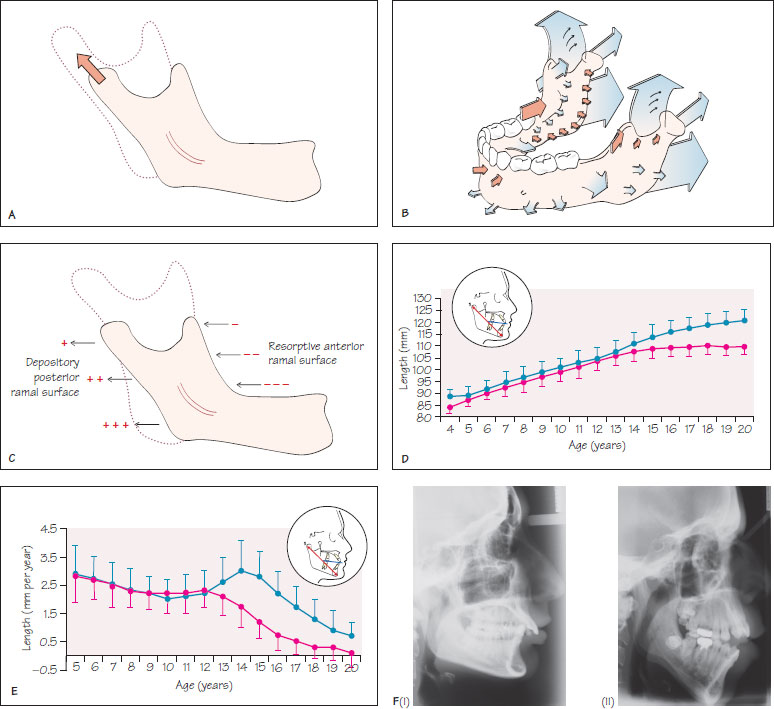5
Growth and development of the mandible
Figure 5.1 (A) The mandibular condyle is thought to respond to the downwards and forwards displacing forces exerted by the functional matrices with upwards and backwards growth by endochondral ossification. This results in primary displacement of the mandible. (B) The mandible undergoes significant surface remodelling during growth. Blue arrows indicate sites of resorption and red arrows indicate sites of deposition. (C) Surface remodelling results in uprighting of the mandibular ramus. The posterior ramal surface is depository whilst its anterior surface is resorptive. Different degrees of resorption and depositon occur along each surface resulting in ramus uprighting. (D) A distance curve for mandibular length showing the cumulative growth of the mandible as a function of age. (E) A velocity curve for mandibular growth showing the average growth per year. For (D) and (E) the blue line shows male and the magenta line female growth. The error bars respresent the standard deviation of each mean value. Mandibular growth was measured between condylion (Cd) and gnathion (Gn) (see inset). Data taken from Bhatia and Leighton, 1993. A manual of facial growth. Oxford University Press. (F) An example of extreme (i) anti-clockwise (forward) and (ii) clockwise (backward) mandibular growth rotation. Note the differences in the lower anterior facial height, overbite, chin prominence and lower incisor inclination.

The mandible forms by intramembranous ossification, which first occurs within the mandibular process of the first pharyngeal arch at 6 weeks in utero. The mandibular condyles articulate with the glenoid fossae, which lie on the inferior aspect of the middle cranial fossa. The mandible grows downwards and forwards from the cranial base, with the vector of growth varying from a more horizontal to more vertical pattern among individuals.
Mechanisms of mandibular growth
Processes involved in the growth of the mandible include:
- Endochondral ossification;
- Surface remodelling;
- Primary and secondary displacement.
The condylar cartilage is a secondary cartilage that differs histologically from the cranial base synchondroses. It provides a pressure-resistant articular surface with multidirectional adaptive growth occurring by endochondral ossification. The condyle usually grows in an upwards and backwards direction (mean = 6° to the posterior border of the ramus), however, this can vary within and between individuals from a more backward to vertical pathway. It is thought that the condylar cartilage reacts by adaptive growth to the downwards and forwards displacement of the mandi/>
Stay updated, free dental videos. Join our Telegram channel

VIDEdental - Online dental courses


